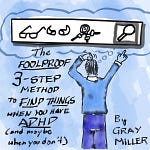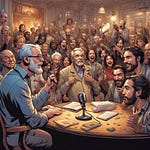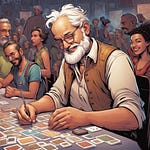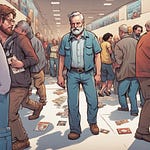
I am an idea machine.
I laugh when I get the spam emails promising yet another course in “how to be more creative.” How is that a problem? I can come up with a dozen ideas for articles, games, stories, projects, you name it, all before my morning coffee is done.
Just one problem: I can’t remember them.
Not in my head, at least. Especially when they’re mixed in with things I need to do, books I want to read, appointments I want to keep, or other administrivia of my life.
“Just capture it in your phone notes app,” is the common wisdom. Which usually goes something like this:
Hey, I’ve got a great idea!
Pull out the phone.
See the notifications on the Home Screen.
Tap one, putatively to unlock the phone, but that takes me to the app that posted the notification.
Maybe that requires a reply or an acknowledgement; it also makes me wonder what else have I missed?
A ridiculously easy swipe down on the screen shows all the othernotifications, each of which loops back to #5.
Any of the number of other app icons on my phone — designed to be eye-catching and fingertip-attracting — might also end up getting in the way of what I actually pulled my phone out to do, which is
To pull up one of a bajillion note-taking apps and actually write down what the original idea was…assuming I can remember it.
Eight steps to catch an idea, on a device where companies have literally spent millions of dollars designing user-interfaces that will catch my attention.
And that’s when the voice in my head says “Why don’t you just…”
Maybe you’re saying it too. “Real first-world problem, Gray. Just stop getting distracted by the shiny icons and beepy notifications and get on with your life.”
You don’t have to say it — I’ve said it to myself, for years. Decades. I just need to buckle down, focus, be disciplined, get serious, or that perennial favorite: grow the %$#@ up.
Someone asked me recently ”Did getting diagnosed with ADHD have any life-changing consequences?” And this is where I can say yes, it did.
Because instead of having some magical thinking that my brain is somehow more powerful than those millions of dollars paid to people whose only job is to distract me, instead of pretending that somehow, someday, I was going to suddenly develop the capacity to not be distracted in spite of decades of research and experience indicating otherwise — I can grow the %$#@ up and recognize that this is not going to happen.
And then figure out what to do instead. Because not only am I an idea machine, thanks to the law of large numbers some of those ideas are even good.
I need to capture them.
My friend, my ally, my notebook.
Once I make the adult decision that my fancy iPhone is not the solution
and that sweet, sweet new app everyone is raving about (I’m looking at you, scrintal/hints/notion) should not be experimented with — then the solution is obvious.
My abiding love of notebooks, small ones, big ones, fancy ones, cheap ones, is another way my brain has been trying to compensate for ADHD. I’ve switched from digital organizers back to notebooks more times than I can count, and have used so many esoteric systems and layouts (and pens! Let’s not forget the pens!) that I could easily write a book about it.
Hey, that’s actually a good idea. What about a big beautiful book with images from the notebooks along with reflections of how they reflected the periods of my life, and…
…and that’s the point when I pause in my typing, and reach for the mini Midori-style notebook sitting just to the left of my keyboard:
The note is captured, put in the pen (ha!) with the last couple of ideas.
The steps are pretty simple:
Open the notebook.
Flip to a blank page.
Pick up the pen.
Write down the idea.
Now, I’m being a bit disingenuous here. In reality, the steps went like this:
Have the idea.
Realize it would be good to illustrate this part of the article with a picture.
Pick up my phone, seeing that a friend who is attending Protospiel in Minnesota this weekend has texted me about a deadline for a creative arts ‘zine has been extended.
Start to wonder if they might want an article about how notebooks can be the way for someone who struggles with attention to capture their creative ideas.
Have the cat jump up on the desk, reminding me that I was about to take a picture, because if I get the cat in the picture people will love the article even more.
Open the camera app, frame the pic, wait for the cat to “photobomb” it (maybe that’s more of a phototrap?).
Take the pic, send it to my laptop and import it into Ulysses (for all the bad stuff about the Apple technosystem, it sometimes really does just work)
Come back to writing the article.
So, yes, another eight steps, and a narrow brush with having my attention diverted — again thanks to the phone.
Also, if you were watching closely, you’ll notice one particularly egregious absence from that list.
I never actually wrote down the idea, until after the message/cat/picture/upload process.
You can relax; I did, in fact, write down the book idea. It’s caught.
Or maybe I should use a less adversarial metaphor, and say it’s planted safe in my idea garden.
No, too consumer-based. It’s comfortable. I created a neat little home for my ideas, furnished it with a decent pen and plenty of room, and even a few friends (“The Obstacle is the Me” and “My ADHD Tax Return”) to hang out with.
Having the notebook is just the start.
I have to bring the notebook with me, everywhere. I have to remember to use the notebook in spite of FOMO messages and cat bombs. I have to build systems in my life that will go back and check on the idea, see how it’s doing, maybe upgrade its home to a posh article or book of its own.
But the first step — Rule One, as Jaclyn Paul writes inOrder from Chaos— is accepting reality.
The reality is that my notebook is the best and primary tool for coping with my ADHD.












